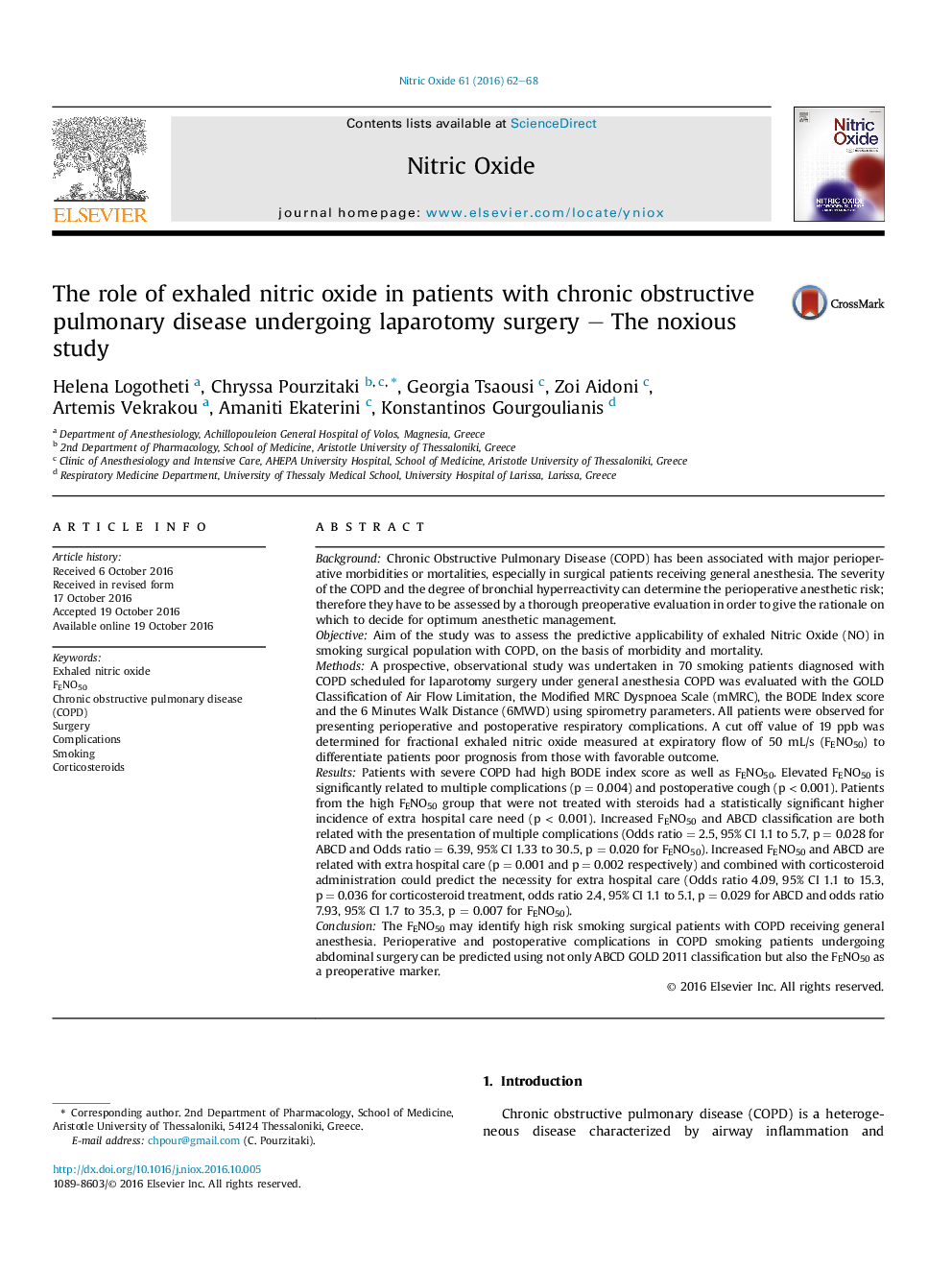| کد مقاله | کد نشریه | سال انتشار | مقاله انگلیسی | نسخه تمام متن |
|---|---|---|---|---|
| 5514297 | 1541599 | 2016 | 7 صفحه PDF | دانلود رایگان |
- COPD patients undergoing major surgeries have high perioperative complication risk.
- Exhaled NO is related with lower airway inflammation and various pulmonary diseases.
- GOLD 2011 classification combined with FENO50 can indentify high risk patients.
- Complications in COPD surgical patients can be predicted using FENO50.
- Patients with elevated FENO50 not treated with steroids need extra hospital care postoperatively.
BackgroundChronic Obstructive Pulmonary Disease (COPD) has been associated with major perioperative morbidities or mortalities, especially in surgical patients receiving general anesthesia. The severity of the COPD and the degree of bronchial hyperreactivity can determine the perioperative anesthetic risk; therefore they have to be assessed by a thorough preoperative evaluation in order to give the rationale on which to decide for optimum anesthetic management.ObjectiveAim of the study was to assess the predictive applicability of exhaled Nitric Oxide (NO) in smoking surgical population with COPD, on the basis of morbidity and mortality.MethodsA prospective, observational study was undertaken in 70 smoking patients diagnosed with COPD scheduled for laparotomy surgery under general anesthesia COPD was evaluated with the GOLD Classification of Air Flow Limitation, the Modified MRC Dyspnoea Scale (mMRC), the BODE Index score and the 6 Minutes Walk Distance (6MWD) using spirometry parameters. All patients were observed for presenting perioperative and postoperative respiratory complications. A cut off value of 19 ppb was determined for fractional exhaled nitric oxide measured at expiratory flow of 50 mL/s (FENO50) to differentiate patients poor prognosis from those with favorable outcome.ResultsPatients with severe COPD had high BODE index score as well as FENO50. Elevated FENO50 is significantly related to multiple complications (p = 0.004) and postoperative cough (p < 0.001). Patients from the high FENO50 group that were not treated with steroids had a statistically significant higher incidence of extra hospital care need (p < 0.001). Increased FENO50 and ABCD classification are both related with the presentation of multiple complications (Odds ratio = 2.5, 95% CI 1.1 to 5.7, p = 0.028 for ABCD and Odds ratio = 6.39, 95% CI 1.33 to 30.5, p = 0.020 for FENO50). Increased FENO50 and ABCD are related with extra hospital care (p = 0.001 and p = 0.002 respectively) and combined with corticosteroid administration could predict the necessity for extra hospital care (Odds ratio 4.09, 95% CI 1.1 to 15.3, p = 0.036 for corticosteroid treatment, odds ratio 2.4, 95% CI 1.1 to 5.1, p = 0.029 for ABCD and odds ratio 7.93, 95% CI 1.7 to 35.3, p = 0.007 for FENO50).ConclusionThe FENO50 may identify high risk smoking surgical patients with COPD receiving general anesthesia. Perioperative and postoperative complications in COPD smoking patients undergoing abdominal surgery can be predicted using not only ABCD GOLD 2011 classification but also the FENO50 as a preoperative marker.
Journal: Nitric Oxide - Volume 61, 30 December 2016, Pages 62-68
